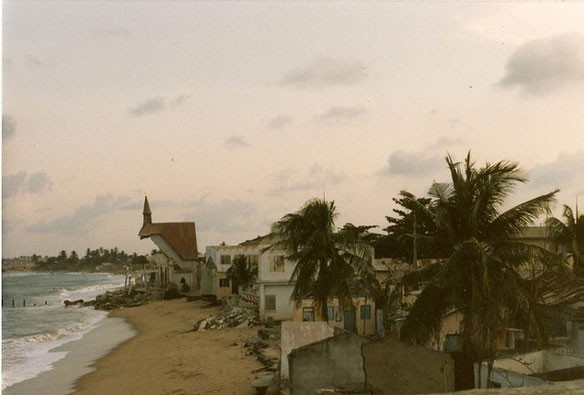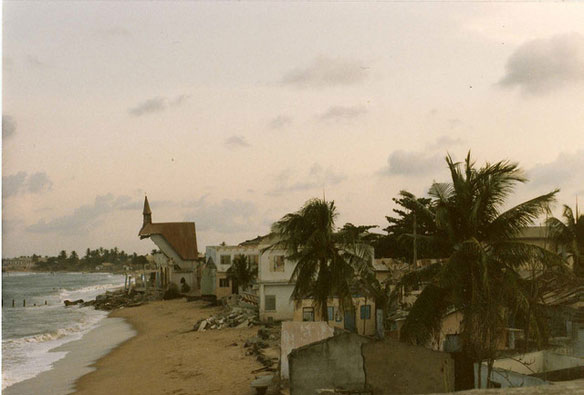
Severe coastal erosion, Keta, Ghana.
Ghana is undergoing much erosion. Photo source: ©© Beth Knittle
“Sand is the second most consumed natural resource, after water. The construction-building industry is by far the largest consumer of this finite resource, followed by the land reclamation industry. The Sand business has been estimated to be a $70 billion industry, worldwide…”Captions by: “Sand Wars” Multi Award-Winning Filmmaker Denis Delestrac (©-2013).
Excerpts;
Ghana’s 168,000-kilometres of Atlantic ocean (Gulf of Guinea) is undulated with batholiths as a dominant feature with stretches of sandy beaches intermittently separated by cliffs or rock outcrops. In between the hills are valleys of various shapes, some occupied by rivers and streams including the famous Kakum river.
However, intensive activities of illegal sand miners at its coastline has exposed tourist facilities and other national edifices to the ravages of the sea…
Read Full Article; Modern Ghana (12-20-2019)
Jobless Cape Coast youth venture into illegal beach sand winning; Ghana News (05-22-2018)
A Photo Gallery: “We Were Once Three Miles From the Sea” (01-03-2014)
Grain by grain, West Africa’s coasts are eroding away, the dry land sucked under the water by a destructive mix of natural erosion and human meddling. Nyani Quarmyne has poignantly photographed the impacts of climate change on people living on the Ghana coast…
The Market For African Beach Sand: Who’s Buying, Selling And Mining It? AFK Insider (02-17-2017)
Sand mining: The Greatest Threat To The Coastline of Ghana, Graphic Online (04-24-2014)
Ghana’s Ongoing Battle Against Coastal erosion (09-09-2011)
According to estimates, the ocean claims 1.5 to 2 metres of the 539- kilometres Ghana coastline annually; with the most risky coastal areas, Ada Foah and the Eastern parts of Keta, recording 4 metres. Ghana’s Government decided on a costly and controversial project: the building of a 68 million euros, 30 kms “Ada Defense Sea Wall” to “salvage the people in the area from the ravages of the sea…”
Sand, Rarer Than One Thinks: A UNEP report (GEA-March 2014)
Despite the colossal quantities of sand and gravel being used, our increasing dependence on them and the significant impact that their extraction has on the environment, this issue has been mostly ignored by policy makers and remains largely unknown by the general public.
In March 2014 The United Nations released its first Report about sand mining. “Sand Wars” film documentary by Denis Delestrac – first broadcasted on the european Arte Channel, May 28th, 2013, where it became the highest rated documentary for 2013 – expressly inspired the United Nations Environment Programme (UNEP) to publish this 2014-Global Environmental Alert.
The Conservation Crisis No One Is Talking About, TakePart (09-21-2016)
Beaches around the world are disappearing. No, the cause isn’t sea-level rise, at least not this time. It’s a little-known but enormous industry called sand mining, which every year sucks up billions of tons of sand from beaches, ocean floors, and rivers to make everything from concrete to microchips to toothpaste…
Sand Wars, An Investigation Documentary, By Award-Winning Filmmaker Denis Delestrac (©-2013)
Is sand an infinite resource? Can the existing supply satisfy a gigantic demand fueled by construction booms? What are the consequences of intensive beach sand mining for the environment and the neighboring populations…? This investigative documentary takes us around the globe to unveil a new gold rush and a disturbing fact: the “Sand Wars” have begun…









